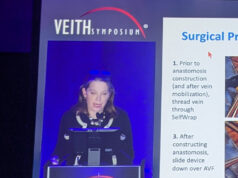
The results of a new study in the Annals of Vascular Surgery suggest that patients who also have a tunnelled dialysis catheter (TDC) do not significantly benefit from receiving a brachiocephalic fistula (BCF) compared with a radiocephalic fistula (RCF).
First author Lenee Plauche and corresponding author Jeffrey J Siracuse (both Boston University Chobanian and Avedisian School of Medicine, Boston, USA) are part of the team behind the study. Their text makes reference to the work of Jonathan Misskey (Vancouver General Hospital, Vancouver, Canada) et al in 2018, published in the Journal of Vascular Surgery, which found that RCFs “demonstrated lower patency and maturation” compared with BCFs for patients aged over 65 years, as well as that they were “an independent predictor of secondary patency loss”.
Studies such as Misskey et al’s lead Plauche and colleagues to suggest that BCFs “have been reported to have higher maturation and patency”. They also note that “more distal creation is encouraged”, while they posit that this can cause delays in the creation of permanent vascular access “and ultimately TDC removal”. Plauche et al’s aim “was to assess short-term outcomes after BCF and RCF creation for patients with concurrent TDCs”, with a view to establishing whether an initial brachiocephalic access may “minimise TDC dependence” and potentially improve outcomes.
For their study, the authors performed a retrospective analysis of data from the Vascular Quality Initiative (VQI) haemodialysis registry from the period 2011–2018. Among the characteristics assessed were patient demographics, comorbidities, and access type, as well as short-term outcomes such as occlusion, reintervention and access used for dialysis.
Of 2,359 patients with a TDC, 1,389 (58.9%) received a BCF while 970 (41.1%) received an RCF. The average patient age was 59 years while 62.8% were male. The authors state: “Compared with RCF, those with BCF were more often older, of female sex, obese, non-independently ambulatory, [more likely to] have commercial insurance, diabetes, coronary artery disease, chronic obstructive pulmonary disease, be on anticoagulation, and have a cephalic vein diameter of ≥3mm (all p<0.05).”
In a Kaplan-Meier analysis of outcomes at one year, primary patency for BCF was 45% to RCF’s 41.3% (p=0.88), while primary assisted patency was 86.7% for BCF compared with 86.9% for RCF (p=0.64). Among the BCF patients, 51.1% did not require reintervention compared to 46.3% for RCF patients (p=0.44). Survival was 81.3% for BCF and 84.9% for RCF (p=0.02).
A multivariable analysis found BCF was “comparable” to RCF on primary patency loss (hazard ratio [HR] 1.11, 95% confidence interval [CI] 0.91–1.36, p=0.316), primary assisted patency loss (HR 1.11 95% CI 0.72–1.29, p=0.66) and reintervention rates (HR 1.01, 95% CI 0.81–1.27, p=0.92). At three months, the type of access used for dialysis was “similar but trending towards RCF being used more often” (odds ratio [OR] 0.7, 95% CI 0.49–1, p=0.05).
Plauche et al’s concluding claim is that BCFs do not demonstrate statistically significant superior fistula maturation and patency rates relative to RCF for patients that also have a TDC. “Creation of radial access, when possible,” they add, “does not prolong TDC dependence.”












